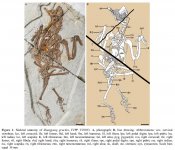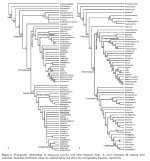Fred Ruhe
Well-known member

Min Wang & Zhounghe Zhou, 2019
A new enantiornithine (Aves: Ornithothoraces) with completely fused premaxillae from the Early Cretaceous of China
Journal of Systematic Palaeontology Latest Articles
Abstract: https://www.tandfonline.com/doi/full/10.1080/14772019.2018.1527403
We report a new small enantiornithine, Shangyang graciles gen. et sp. nov., based on a nearly complete and articulated skeleton from the Lower Cretaceous Jiufotang Formation of Liaoning Province, north-eastern China. Shangyang has premaxillae that are completely fused rostrally as well as along the frontal processes, a previously unrecognized condition in Early Cretaceous birds. As in three other enantiornithine taxa, Shangyang preserves a pair of craniolateral processes in the sternum. Phylogenetic analysis places Shangyang in a relatively derived position within Enantiornithes, suggesting that the craniolateral processes of the sternum evolved independently among some enantiornithine lineages from the condition seen in some basal ornithuromorphs. The craniolateral processes in modern birds provide the insertions of the M. sternocoracoideus that functions in the downstroke, which can also originate from the two cranialmost sternal ribs instead when these processes are absent. The altered origin of this muscle shows that diverse pectoral musculoskeletal modifications took place early in avian history.
http://zoobank.org/urn:lsid:zoobank.org:pub:20C69B6A-473B-4C6D-9672-F5B2CC2D8FE1
Keywords: birds, Enantiornithes, fusion, M. sternocoracoideus, Mesozoic, sternum
Enjoy,
Fred
A new enantiornithine (Aves: Ornithothoraces) with completely fused premaxillae from the Early Cretaceous of China
Journal of Systematic Palaeontology Latest Articles
Abstract: https://www.tandfonline.com/doi/full/10.1080/14772019.2018.1527403
We report a new small enantiornithine, Shangyang graciles gen. et sp. nov., based on a nearly complete and articulated skeleton from the Lower Cretaceous Jiufotang Formation of Liaoning Province, north-eastern China. Shangyang has premaxillae that are completely fused rostrally as well as along the frontal processes, a previously unrecognized condition in Early Cretaceous birds. As in three other enantiornithine taxa, Shangyang preserves a pair of craniolateral processes in the sternum. Phylogenetic analysis places Shangyang in a relatively derived position within Enantiornithes, suggesting that the craniolateral processes of the sternum evolved independently among some enantiornithine lineages from the condition seen in some basal ornithuromorphs. The craniolateral processes in modern birds provide the insertions of the M. sternocoracoideus that functions in the downstroke, which can also originate from the two cranialmost sternal ribs instead when these processes are absent. The altered origin of this muscle shows that diverse pectoral musculoskeletal modifications took place early in avian history.
http://zoobank.org/urn:lsid:zoobank.org:pub:20C69B6A-473B-4C6D-9672-F5B2CC2D8FE1
Keywords: birds, Enantiornithes, fusion, M. sternocoracoideus, Mesozoic, sternum
Enjoy,
Fred





